XIII. SILVER TABBY PERSIANS
Texte und Bilder aus “THE BOOK OF THE CAT” von Frances Simpson aus dem Jahre 1903
THE BOOK OF THE CAT
CHAPTER XIII.
SILVER TABBY PERSIANS
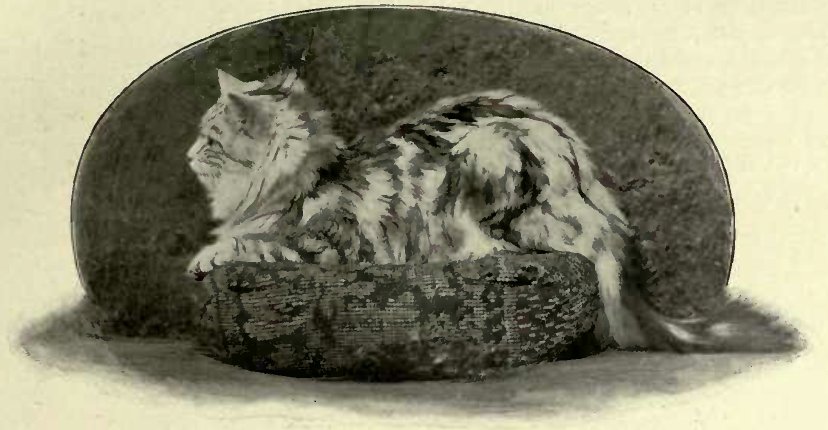
THERE can be no question that a really _L good silver tabby will carry off the palm even from the most exquisite unmarked silver cat, and in this assertion I feel I have the support of all our professional judges, for with the “ mere man,“ it is well known, the pale silvers do not stand high in favour. Men call them “ wishy-washy,“ insipid, and wanting in expression, and are generally displeased at this sport in the fancy that has spoiled the handsome silver tabbies of years gone by.
No doubt there is just cause for complaint, for the inter-breeding of silvers with silver tabbies has undoubtedly done much to destroy the clear defined markings which in tabby cats is their chief glory. Now, of course, it is easily understood that these tabby markings in a long-haired cat cannot be so distinct as those that appear to such advantage in the short-haired breeds. “ The better the coat the weaker the markings,“ may be said of Persian silver tabbies, and judges have been known to give the highest award to an out-of-coat specimen just because the markings are more evident than in a cat in full pelage. Harrison Weir states that “ Tabby is not a Persian colour,“ and goes on to say, “ Nor have I ever seen an imported cat of that colour.“ His definition of a silver tabby reads thus :—“ Markings : Jet-black lines, not too broad, scarcely so wide as the ground colour shown between, so as to give a light and brilliant effect. When the black lines are broader than the colour space, it is a defect, being then black marked with colour, instead of colour with black. The lines must be clear, sharp, and well-defined, in every way distinct, having no mixture of the ground colour. Head and legs marked regularly, the rings on the throat and chest being in no way blurred or broken, but clear, graceful, and continuous ; lips, cushions of feet, and the backs of hind legs, and the ear points, black.“ And here it will be interesting to give the discussion which took place and the list of points drawn up at the inaugural meeting of the Silver Society in 1900, and which standard is still adhered to in the present Silver and Smoke Persian Cat Society :— SILVER TABBIES.
At the meeting of the Silver Society, discussion arose as to whether the markings on silver tabbies
Head and expression Colour and markings Colour of eyes . . Coat and condition Shape Brush
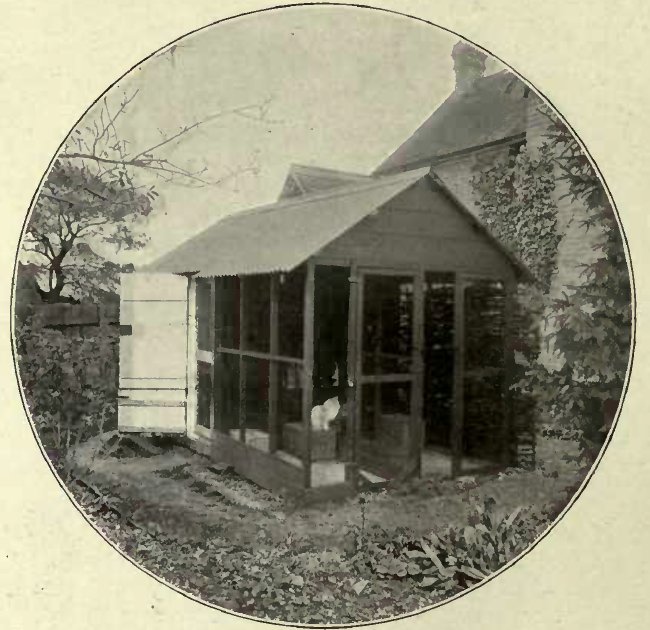
Total should be broad or narrow. Lady Marcus Beres-ford proposed that Miss Leake and Mrs. Herring should be asked to express an opinion, both being breeders of prize winners. Miss Leake said she thought there were two distinct types of cats, the one with broad markings, the other with narrow stripes, and that both were correct silver tabbies, the superior beauty of either being a matter of personal opinion. Mrs. Herring agreed, and said the markings should be a dense black. Miss Leake considered they should be black at the tips, but shading to light at the roots. Mr. Abbott objected to the word “ dense,“ as black was black, and the word “ distinct “ was substituted. Finally the following was resolved :—The colour of a silver tabby should be a pale clear silver, with distinct black markings, any brown or cream tinge to be considered detrimental. The eyes should be orange or green :
The adoption of the preceding descriptions and scale of points as a whole was carried unanimously.
As regards the eyes of a silver tabby, Harrison Weir says “ deep bright yellow.“ The Silver Society gives an option of “ orange or green “ ; but the mandate of present-day fashion and personal bias is in favour of green eyes for silver tabbies. From an artistic point of view, there is no doubt emerald green is a better contrast to silver than yellow or orange.
The Rev. R. Maynard, whose name has for many years been connected with silver tabbies, recently complained in the papers of the tendency to breed green eyes in this variety. He writes : „In former days we never had anything to do with a cat that had green eyes, and now that so much is being done to improve the feline race, why should we try to think the green eye right and even desirable ? “ Another authority says: “ The fiat has gone forth that silver tabbies are to have green eyes. Happily there still remains room for a difference of opinion on the subject, for the oldest and most perfect breeds of silver tabbies have always been distinguished by their deep hazel eyes.“
This vexed question of eyes, certainly outside the “ self “ classes, ought not to be one of such vast importance. As Louis Wain aptly writes when complaining of this undue proportion of points, “ Everyone, judges and exhibitors alike, are bitten by the craze for the ‚ correct coloured eyes.‘ ‚
It is a fault tabbies, of long- or short-haired cats. In judging a class of tabbies, first and foremost in the judge’s estimation must rank the markings, and in Persian tabbies coat must next be taken into consideration. I have always thought that judging long-haired tabby cats in a ring class would be specially welcomed both by judges and exhibitors, for it is when a good cat of this breed runs or walks the beauty of his markings can be seen and admired^ -Then the dark spine lines will show up to advantage, the side markings will stand out, and the bars on the legs and the rings round the neck may be clearly discerned. I think it is not to be wondered at that fanciers who have bred tabby cats are not easily satisfied as regards selfs and silvers.
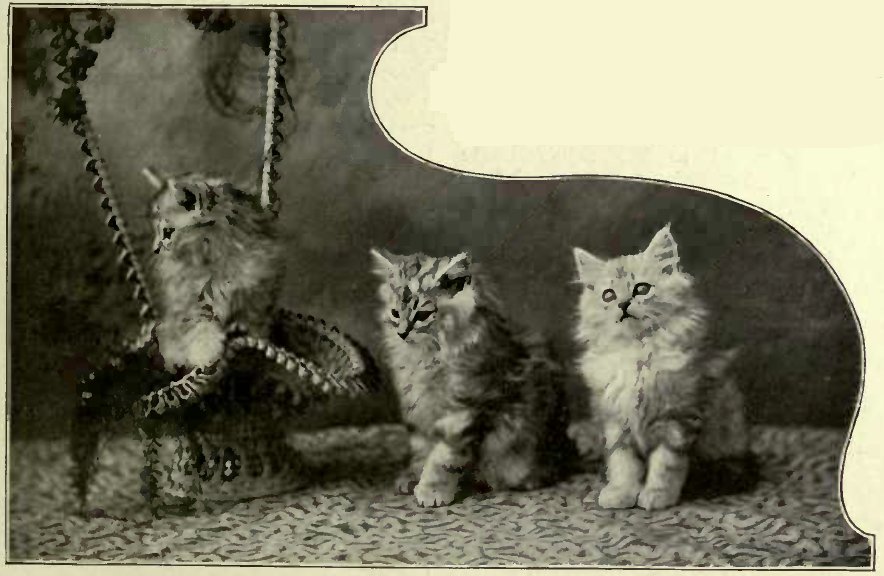
A friend of mine declared, “ I always miss the stripes which give a tabby cat such a sweetly expressive countenance.“ Yet in spite of the beauty of the silver tabby, there are very few fanciers of this variety, and to those wishing to take up Persians I could not recommend a more interesting field for speculative breeding.that judges are prone to commit, and truly The number of good show specimens can be one point ought not to be allowed to outweigh counted on the fingers of one hand. Silver others, and it is just this balancing of merits Tabby classes at our shows are full of nonde-with a mingling of common sense that makes script cats with shaded silver bodies and the good all-round judge, whether of self or markings only on legs and head.
When judging the silver tabbies at the Crystal Palace in 1902, I was greatly struck with the number of cats and kittens which ought really to have been marked “ Wrong Class,“ for some of these were absolutely wanting in any definite marks at all; some had faint grey pencilling on the head and legs, but not a sign of the dense mottling on the sides. It is, no doubt, disappointing to exhibitors to have their specimens labelled “ Wrong Class,“ or for really lovely kittens to be passed over without even a card ; but it is only by thus treating exhibits so lacking in the essential point of the class for which they are entered that fanciers will learn to discern between the genuine article and what may be called a spurious one. These pretty nondescript silvers, which are neither one thing nor the other, should be disposed of as pets ; but to enter them at our shows in • classes for tabbies is only throwing away money and risking the animals. No cat has come nearer to the perfect ideal of a silver tabby in our day than Lady Pink’s “ Shrover II.,“ now gathered to his fathers. He possessed the wonderfully clear silvery white ground with distinct dark markings, and was always the admired of all admirers at our leading shows. Lady Pink is not without some worthy descendants of her famous “ Shrover II.,“ and writes to me thus : “ I have a smoke male by ‚Shrover II.,‘ and hope to show him at Westminster. ‚Shrover III.‘ is just like his father ‚Shrover II.,‘ but I shall not exhibit him, as I am too afraid of losing him. I have suffered man y losses after shows. ‚ Shrover III.‘ is a fine, big fellow, even better marked than his father, with long silky, wavy coat, lovely eyes, and a perfect temper.“
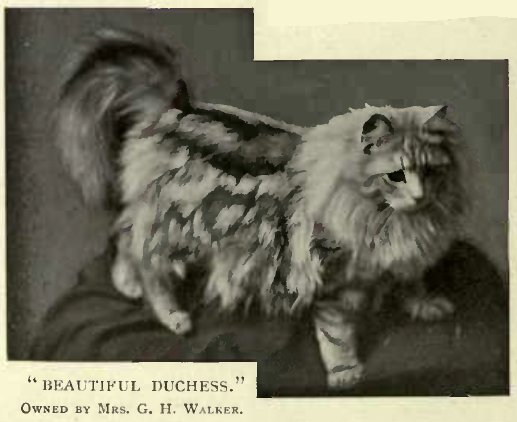
Mrs. Herring has bred some fine silver tabbies, notably “ Duchess Lestock,“ a sensational kitten at the Westminster show of 1900, when she was claimed at a high price by Mrs. G. H. Walker, of Woodheys Park. Mrs. Herring’s “ King Alfred “ was the sire of “ Shrover II.,“ and is quite “ one of the best.“ Miss Anderson Leake is justly celebrated as a most enthusiastic and successful breeder of silver tabbies, and is our greatest authority on this variety. As far back as 1887 “ Topso of Dingley “ was exhibited by Miss Leake at the Crystal Palace. This cat was said to be of Irish descent, but his ancestors were sunk in oblivion. Not so, however, his progeny, for the winnings of his son “ Champion Felix,“ owned by Miss F. Moore, of Beckenham, are fresh in the minds of those who, like myself, can remember beautiful cats of bygone years. In 1889 Miss Leake entered “ Topso “ and two toms in a class for “ blue or silver tabbies, with or without white.“ “ Felix “ was also in this class, as a winner of the Challenge Cup. Miss A. Leake’s “ Abdul Zaphir “ and the present representatives of the breed “ Abdul Hamet“ and “ Marquis of Dingley“ are household names amongst silver tabby fanciers. Miss Derby Hyde has long been faithful to this breed, and “ Thames Valley Silver King “ and “ King Alfred “ have often had to fight it out together at our shows, sometimes one being favoured by the judge and sometimes the other carrying off the honours. Miss Cope has recently been bitten with the silver fever, and her tabby kittens are always to the fore. Her „Roiall Fluffball“ took first and seven specials at Westminster in 1901, and her „Silver Tangle“ is a well-known winner. Mr. Furze, another Midland fancier, is also making a speciality of silver tabbies, and the Hon. P. Wodehouse possesses a fine silver tabby female in “ Silver Saint.“ Mrs. Slingsby owns “ Don Pedro,“ a beautiful specimen, and Miss Meeson has bred some good silver tabbies as well as silvers. But the ranks need filling, and with the assistance of the society now in existence the classification at shows will become more liberal, and instead of silvers and browns being often placed together at our smaller shows, separate classes are guaranteed, for it is certainly most unfair on judge and exhibitor to place these two very distinct breeds together. “ Comparisons are odious,“ we are told, and certainly it is hard on the brownies for the more brilliant silvers to be placed side by side in competition. As regards the mating of silver tabbies, the essential point to try and breed for is markings, and it behoves the fancier to endeavour to find a sire with bold, distinct tabby markings, and if it is desired to strengthen the colour, then a black is not at all a bad cross. There are two distinct kinds of tabbies—the blotched and the pencilled varieties ; and it is a matter of choice which is considered the handsomest. But it does not do to mate these two varieties together. A well-known authority on breeding silver tabbies writes thus in Fur and Feather: —“A great deal has been said as to the disadvantage of crossing chinchillas with silver tabbies, but we think this applies more to the detriment of chinchillas than of tabbies. Provided the tabby, on one side, is of a very decided type, the chinchilla, having come originally from the same stock, may not prove a bad cross. Miss Cope’s ‚ Silver Tangle,‘ for instance, one of the best-marked silver tabby queens, is the child of the chinchilla ‚ Silver Chieftain,‘ and of a queen bred from a silver tabby sire. A good young queen, belonging to Mr. Hoddi-nott, was bred from ‚ Lord Argent ‚ and a tabby mother. ‚ Champion Felix ‚ was bred from ‚ Topso,‘ a heavily marked tabby, and ‚ Lady Pink,‘ a cat that would nowadays have been called a light shaded silver with white markings. ‚ Climax‘ came of the same parents, and both have broad dark markings, and transmitted them to their offspring. The union of two strongly marked silvers is not always a complete success. A brown tabby makes a most excellent cross, and some of the purest and best silvers we have seen have been obtained in this way. Of course, you must be prepared for a brown tabby kitten or two ; but you need not fear sandy smudges and yellow noses. The colour seems to be concentrated in one or two examples, and leaves the silver free. In short, in colour breeding we must be content with one or two perfect specimens in a litter, and, retaining them, try again for yet further perfection.“
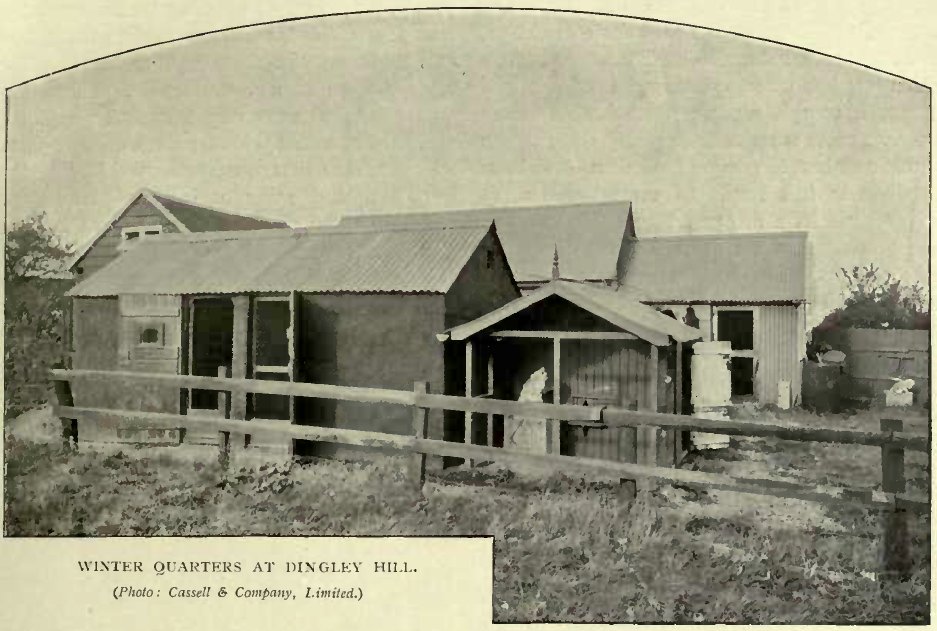
‚The cat fancy needs some new sensational cat to appear on its horizon, and if only a perfect silver tabby, male or female, could be penned at one of our leading shows a great impetus would be given to this variety, and a thoroughly good strain might be established. Then we should not read such remarks as these from the pen of the reporter : “ The silver tabbies, we regret to say, were only a shade of days that are gone. There is room for an enterprising enthusiast in this breed. The beautiful clear silver colour with deep black markings seems to be quite a thing of the past. Who will revive them ? “ And echo answers, “ Who ? “
From such an authority as Miss Anderson Leake the following article on silver tabbies will be of great interest, and the photos of her cattery at Dingley Hill, Bradfield, near Reading, have been specially taken to illustrate these notes :—
“ Possibly amongst the rarest of our longhaired cats may be classed the really well-marked silver tabby. Twenty years ago he existed, and was, indeed, more commonly met with than to-day. For at that time chinchillas were practically unknown, save for a few scarce specimens, and the silver cats of that day were more commonly called ‚ grey‘ Persians, and were nearly always tabbies. But with the popularity of the pale chinchillas began the downfall of the heavily marked
tabby. Instead of breeding for the preservation of markings, everyone worked their hardest to breed out markings, -and real tabby kittens were almost unsaleable. Those that were produced were very frequently ventured, and sold at a low price for pets. The lightest specimens in a litter were preserved for breeding purposes, and rarer and rarer became the deeply marked silver tabby. But at last the tide has turned, and people are beginning to realise that there is a character, a beauty, and a contrast of colouring in a good tabby, which lend to them a charm all their own. Added to this, they are exceedingly rare and difficult to produce.
“ Competent judges agree that to breed regular, symmetrical, and well-coloured markings is no easy task, for contrast is the grand point in a silver tabby. His ground coat from tip to tail should be pure pale white silver. On this light silver ground-work lie the most beautiful even dark mottlings, dark to the point of blackness. These markings are most difficult to describe. A dark stripe runs the whole length of the spine. Then comes a light stripe on either side, then two more dark stripes, but these are broken just behind the shoulder by a transverse bar of light silver, and widen on the shoulder into considerable sized patches. The markings on the sides are not stripes, but patches, elliptical in shape, generally three in number, and partially encircled by dark stripes. The shoulder is particularly heavily barred and striped, as are also the hind quarters. The legs are barred throughout their length, the face should be dark, with dark tufts, and the back part of the hind legs from the knee downwards is black, as in a Southdown sheep. “ The head is most beautifully pencilled, the cheeks possess double or treble swirls, the eyes are outlined by dark rims; on the forehead the lines form a complete triangle, which is repeated at the nape of the neck. The chest is encircled with a perfect dark ring, called the ‚ Lord Mayor’s chain,‘ but this is concealed when the large light frill is in full beauty, as is also the neck triangle. The whiskers often contain all the different shades of colour found in the coat. The ear tufts should be long and light. The tail is generally ringed from trunk to tip, but this is not noticeable after kittenhood, owing to the great length of the hair. Also the hair to the root is much darker in colour on the tail than on the body.
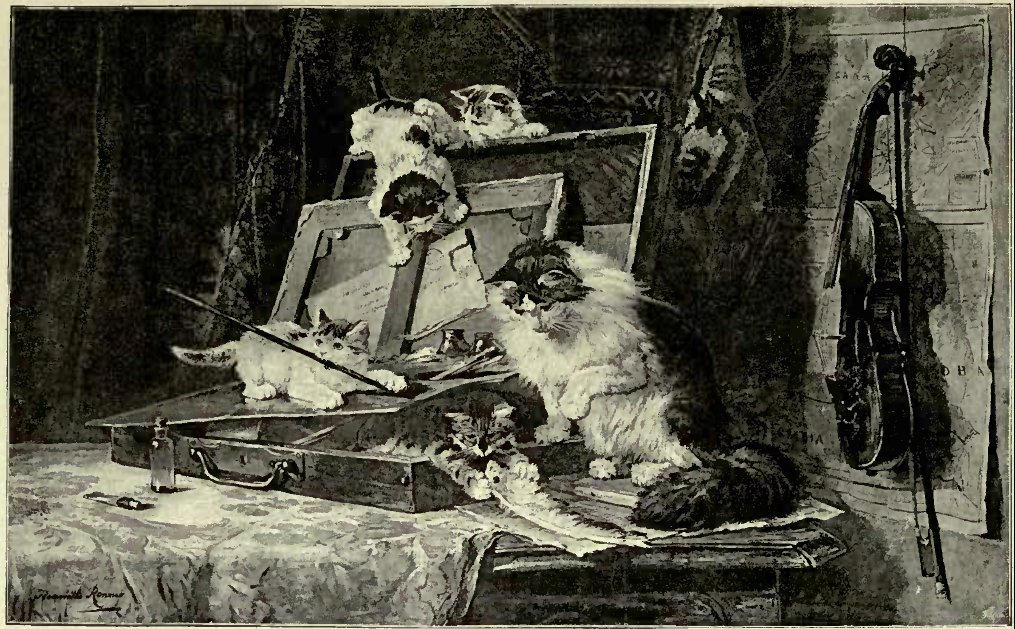
“ The correct colour for the eyes of a silver tabby is neither green, orange, nor yellow, but hazel—a deep nut-brown. This shade of eye is very difficult to obtain, and it fades with age ; but once seen, its beauty and suitability to the colouring of the cat will never be denied. Many of the most noted prize-winners have not possessed this coveted hazel eye. The nose is by preference dark, but this, so far, has not been considered as a point.
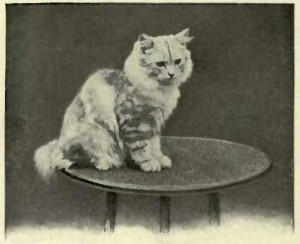
“ Not only evenness and regularity of markings go to the making of a good tabby, but sharpness and depth of colour in the dark parts, and clearness of colour in the light parts. A great deal has been said of late regarding the depth of the black markings ; but it is quite as necessary to insist on the purity of the silver tone. No suspicion of brown must be tolerated, neither any blue nor grey tone.
„There is no question that, as a tabby, a long-haired cat is handicapped by his length
of coat. There are some people who would rob him of his crowning glory in order that his beautiful striping may the better appear. But surely it were better for them to confine themselves to short-haired cats if they cannot appreciate the marvel of long-haired tabby markings. For marvellous they truly are, when we consider that the dark marks are only formed by tips to the hair of some quarter of an inch in length. When the coat is quite short these tips are massed together, and the blackness is, so to speak, concentrated. When the hair is at its full length—of from two to four inches—it can be readily understood that the long floating locks mix and mingle with the paler coat, and some distinctness of marking is lost. The massive frill and the long light shoulder tufts give the cat a very pale frontage ; and if he be placed in a show pen side by side with a cat whose coat is just coming, whose marks show up, in all probability he will take a second place. No stroking, blowing of the coat, or other device will show off a tabby cat. He must be made to get up and walk. Then the long coat falls apart, the spine lines reveal themselves, the side patches fall into place, and bars, stripes, swirls, and rings all are to be seen. Even then you will not see them all at once, but as he moves and turns one by one the points will show themselves. As a show cat, a tabby is not a success, for his period of perfect beauty is exceedingly short. When he proposes to moult he changes colour, and if you are unwise enough to exhibit him at this stage ominous whispers of ‚Brown tabby blood‘ will pass from mouth to mouth. For a thorough good rusty brown shade, commend me to a moulting silver tabby. Then a little later he completely loses his side markings, and you must wait until the new coat makes its appearance before you can venture him in the show pen. In the first beauty of that new coat, when the hair is about an inch long, he is a dream of colour contrast, and somehow suggests such ineffable cleanliness!
“ How to breed silver tabbies is a moot point. One thing is certain, that if we expect whole litters of well-marked kittens we shall be grievously disappointed. Personally, we have had the best results from pairing two marked cats slightly related and of good silver pedigrees. A smoke of silver origin is another good cross, but the sire should always be a tabby. The blacker the kittens are at birth the better. There is no sign of light undercoat, but generally narrow pencillings of silver are to be seen, and face and paws are fairly light. The kittens which at birth show contrast of dark and light rarely turn out good tabbies. The markings, as a rule, become too faint. At a month old the light markings should widen and develop, and at three months old the full beauty will be seen. Before the change to cat coat, many of the kittens become more shaded than marked, and up to the sixth or eighth month there is always a possibility of their proving disappointing. If, however, after this age the markings return, harden, and develop, they will endure for ever, except during periods of moulting. In extreme old age both the purity of colouring and distinctness of markings are lost. Exposure to the sun considerably injures the colour of the silver tabby cats, giving them a brown tinge. We believe exhibitors of magpies never allow their birds to enjoy the rays of the sun for a similar reason, but it is a question whether it is not wiser to study the beneficial effects of a sun-bath on the health of our cats rather than the slight detriment to their coats caused by its enjoyment. I have said nothing about size and shape. The silver tabby should be a large cat, with good bones, and very heavily coated. The old-fashioned cats were very long, low on the legs, and a trifle narrow in head. Nowadays we have remedied this defect, and the modern cats are decidedly more cobby than their progenitors. The ears should be set wide apart, and be small and not too sharply pointed. If only fanciers will now devote themselves to the production of such cats as I have tried to describe, we shall soon see the silver tabby classes at our shows filled with typical animals, instead of, as is too often the case, with spoilt silvers, too heavily marked to be called chinchillas, too unevenly or lightly marked to be correct tabbies.“
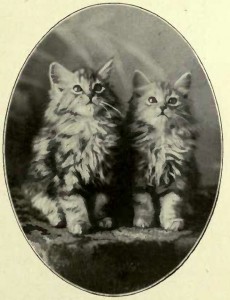
I have mentioned Miss Cope as a breeder of silver tabbies. Her remarks on her favourite breed are as follows :—
“ There is no doubt that until quite recently interest in this fascinating breed had, to a great extent, died out, owing to the craze for chinchilla breeding. But I hope their day-is-coming again. There is a marked improvement already shown in the silver tabby classes at the best shows.
“ Mr. St. George Mivart, in his celebrated book, asks, ‚ What is a cat ? ‚ But even so simple a question as that appears from his statement to be more easily asked than answered. The same may be said of the question, ‚ What is a silver tabby ? ‚ I will endeavour to answer the question by giving my own idea of what may be considered to be a perfect type of a silver tabby. The chief point of a silver tabby should be clearness and distinctness of markings ; the sharper they are the better. My ideal cat would have the two spine stripes clear and well denned from shoulder to base of tail, set off by the ‚ epaulet ‚ behind each front leg. On each side of the body should appear what may be called the horseshoe ; both sides should match exactly. The hind-quarters well barred. The fore-legs should also be barred, each in symmetrical correspondence the hazel eye, enhanced by dark rims. Happily, latitude is allowed in this direction in the standard drawn up by the Silver Society, which decrees the colour shall be the green or orange. But with all these, my ideal silver tabby must have perfect shape of body, so far as it is possible to obtain it, as well as luxuriance of coat. The long, thin-bodied, snipy-headed, spindle-legged cat is an abomination. The ideal cat must be cobby, with short, thick legs, the head broad and massive, with the other. The double cheek swirls, the markings on the forehead, which may be easily imagined to take the shape of a lyre, the shaded eyebrows and whiskers, and dark outlines to the eyes, all these give a character to the face not found except among tabbies. More or less conspicuous will be the dark lines across the chest, known as the ‚ Mayor’s Chain.‘ Occasionally some more favoured animal is found to have two such lines. The beauty of all these markings is thrown up by the ground colour of the coat, which should be a clear bright silver. The whole effect, if one may so describe it, is like a piece of elaborately wrought black lace on lustrous silvery silk. The colour of the eyes is somewhat a vexed question.

Some fanciers prefer green. Personally, I think nothing is more lovely than ears small, well tufted and set wide apart, the nose short and wide at the tip, the tail short and wide at the extreme end—I consider a pointed tail very undesirable. The coat of the ideal silver tabby should be long – and thick, and the texture as silky as possible. “ Having described my ideal silver tabby, the next question is how to get it. When I succumbed to the fascination of the longhaired beauties some years ago, I resolved to breed only from the very best stock obtainable, and I have unflinchingly adhered to this rule. I would like to impress upon anyone starting this delightful hobby that it is absolutely a waste of time and money to attempt breeding from any but the best. The observance of this principle will save many disappointments, much heart-burning, and not a little money. Having made up one’s mind which breed one admires most, it is far better to keep to that particular variety, and win success worth having, than to dabble in a variety of breeds with only a moderate amount of success. To a rigid observance of these principles I owe any honours in the show pen which have been awarded to me. It is of little use taking up the breeding of long-haired silver tabbies unless one is possessed of unlimited patience and perseverance. It is sometimes very disappointing to find the kitten one fondly hoped would prove a coming champion merging into a shaded silver—exquisite in colour and as far as head, shape, and coat are concerned, but none the less not a silver tabby. Here comes in the study of pedigree. It by no means follows that the mating of two tabby parents will result in a litter of pure tabby kittens, unless both sire and dam are of pure silver tabby lineage. Hence purity of pedigree on both sides is of great importance.
„If there is a trace of chinchilla blood in the ancestry it is certain to manifest‘ itself at odd times in the progeny. Nevertheless, do not despise your shaded silver, if it be a queen, providing all other points are perfect. As Miss Leake says—and I quite agree with her
‚ You no longer have a show specimen, but you have a cat that, crossed with a heavily marked cat, will probably provide you with splendid silver tabbies.‘ This, however, can scarcely be called the true science of breeding, as the progeny of two such cats may hark back to some of the original characteristics.
“ My own practice is to mate silver tabby with silver tabby invariably, and of the purest pedigree I can find. I should never breed from a sire that I knew possessed a brown tabby ancestry. I would far rather choose a good black sire, and in this way strengthen the markings. Of course, one would not expect a mating of this kind to produce a litter of champion silver tabbies ; but if I secured one well-marked kitten I should feel quite repaid. On the general question of breeding, Mr. C. A. House, who is no mean authority, and whose suggestions I have often followed with advantage, recently said: ‚ If I were asked to pick out in a certain cattery a pair of silver tabby Persians which would be likely to make a good match, I should proceed on lines similar to the following :—Shape and size with quality of coat I should expect the dam to possess. Marking, colour, length of coat, colour of eye, and strength of bone, I should demand in my sire. This is, of course, if I were selecting from cats whose ancestry was quite unknown to me. My reasons for so doing are because in nine times out of ten the sire influences the outward characteristics of the progeny, while in like ratio the dam exercises her influence over those points which are more hidden. The dam has far more to do with shape than is generally supposed, and I would rather breed from a bad-headed male than a bad-headed queen. Quality of coat must always be looked for in the queen.‘
“ With regard to in-breeding I have no hard-and-fast rules to lay down. The whole matter, in spite of what one and another may say, is too experimental and speculative for anyone to dogmatise. The authority I have just quoted remarks on this matter: ‚ It sometimes happens that a fancier puts together two animals which excel in some particular property, yet not one of their progeny is above the standard of mediocrity, so far as that property is concerned.‘ Experience has shown me the importance of studying the weak points of the dam. These I try to remedy in selecting the stud cat. But with all my care I sometimes find ‚ the best laid schemes . . . gang aft agley.‘
“ For the successful keeping of cats and rearing of healthy kittens, my prescription begins and ends with two words—liberty and fresh air. I have found cats can stand any amount of cold, providing, of course, they have never had artificial heat previously. Two things must be carefully guarded against —damp and draught. These are fatal. Kittens so reared will be healthier, grow better coats, and will be much better able to stand the wear and tear of show life. My own cats live in wooden houses, raised at least one foot from the ground, the size at least seven and a half feet by five and a half feet. Each house is fitted with an inner wire door, as well as the outer wooden one. Along the entire length of the upper part of one side is a wire netting window, with a broad shelf fitted beneath. This opening has also a sliding shutter fitted with glass panels. I am thus able to give ventilation at will, or fasten them up securely in bad weather. In one corner of the house is a cosy sleeping box : in another corner an equally cosy chair. All cats love a chair. Cats kept outside, when they are admitted to the house, invariably find out the most comfortable corner of the most comfortable chair. In such a house as I have described, kittens can be successfully reared ; there is ample room for them to scamper round should a wet day keep them in. Unless it is absolutely raining all my cats have the run of a large garden the whole day, and are only shut up at night. I never coddle my kittens, but try to bring them up as naturally as possible. “ I am sometimes asked how it is my kittens attain such good proportions. The secret, if secret there be. lies in this—I never allow my mother cats to nurse more than two kittens after the first week. If a foster cannot be found, I select the two I consider the most promising, and the lethal chamber claims the rest. Some may consider this foolish. I can only say I would far rather rear two thoroughly healthy kittens than five or six little puny things that will require weeks of care and attention, and then fail to reach the end in view. Baby silver tabbies, I must admit, are not altogether things of 1 beauty and of joy. More often than not they are dark and uninteresting. The time to decide which is the best marked kitten is while the coat is comparatively short. When compelled to make a selection, I usually give the preference to the darker kittens. Experience has taught me that the lighter kittens, so attractive in themselves, even at that early stage, and whose colouring is so exquisite at eight or nine weeks old, are apt to prove deceptive in the end, and often develop into shaded silvers.“
To Miss Cope’s last statements I can add my testimony, but I will also mention a curious case coming under my direct notice and regarding my own silver stud cat. “ Cambyses “ is by “ Mowgli “ (a noted pale silver of “ Silver Lambkin “ strain) and a handsome silver tabby unknown to fame, being a house pet. When I became possessed of “ Cambyses,“ then five months old, he was a decided silver tabby, taking after his mother ; he has since shed all his markings, except faint grey pencillings on head and legs, and is one of the lightest silvers at stud. When mated to smokes and silvers I have not known or heard of any tabbies in the litters ; but on one occasion, when crossed with a silver tabby, he had some very densely marked tabbies. I have remarked that this beautiful breed of Persians has not been taken up by American fanciers in the same enthusiastic manner as have blues, orange, and especially silvers. In an account given by Field and Fancy of the Beresford Cat Club show in New York, January, 1903, I find mention made that over 125 long-haired cats were entered, and that in the silver classes alone there were thirty-five entries, almost as many as were entered in the whole long-haired section of the previous year. The smoke male class was cancelled, but eight females of this breed put in an appearance. No mention is made of silver tabbies. Amongst the winners of the challenge cups offered by the Atlantic Cat Club, a silver tabby called “ Queenie,“ owned by Mrs. Wagner, carried off the trophy. Miss A. Leake, of silver tabby fame in the English fancy, has exported some of her stock, and no doubt our American cousins will not let this beautiful breed remain long neglected, but some enthusiastic fancier will establish a strain on the other side of the herring pond.
At the Westminster Cat Club show of 1903, held about the same time as the Beresford New York show, the entries in the three classes provided for silver tabbies numbered twenty-seven, which is an increase on previous years, who is the best-marked silver tabby that is but with two or three exceptions quality was now before the public. Miss Cope must lacking. No new names appeared in the cata- be proud of having bred so fine a specimen logues, and Miss Anderson Lecke and Miss by Miss Anderson Lecke’s “ Abdul Hamel of Dingley,“ whose picture appropriately Roiall forms the heading of this chapter on silver
Cope carried off the highest honours. The winner in the female class was Fluff ball,“ whose portrait appears below, and tabbies.

